In conjunction with the ongoing global negotiations of the 4th International Conference on Chemicals Management (ICCM4) organized under the auspices of the United Nations Environment Programme’s Strategic Approach to International Chemicals Management (SAICM), CIEL and Ban Toxics released a series of issue briefs highlighting the human rights implications of six highly toxic pollutants.
The issue briefs focus on five chemicals and one hazardous waste stream of global concern: mercury, lead, phthalates, pesticides, decaBDE (an additive flame retardant), and electronic waste or e-Waste. The briefs provide an overview of the chemicals of concern and the human rights implications of each.
The implications of toxic chemicals on human rights are countless. The vulnerability of children, poor and marginalized communities, indigenous peoples, and other vulnerable populations to disproportionate levels of exposure to toxic chemicals raises critical questions around fundamental human rights principles, such as equality, non-discrimination, and self-determination.
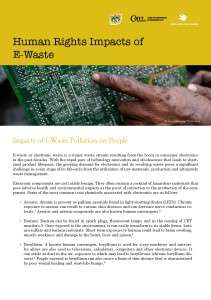 e-Waste: E-waste or electronic waste is a major waste stream resulting from the boom in consumer electronics in the past decades. With the rapid pace of technology innovation and obsolescence that leads to shortened product lifespans, the growing demand for electronics and its resulting waste poses a significant challenge because electronic components are not totally benign. They often contain a cocktail of hazardous materials that pose adverse health and environmental impacts at the point of extraction to the production of the component such as: arsenic, barium, beryllium, brominated flame retardants (BFRs), cadmium, hexavalent chromium, lead, mercury, polyvinyl chloride (PVC), phthalate esters. In its final life-cycle stage, e-wastes remain a major challenge. Read in English | Español
e-Waste: E-waste or electronic waste is a major waste stream resulting from the boom in consumer electronics in the past decades. With the rapid pace of technology innovation and obsolescence that leads to shortened product lifespans, the growing demand for electronics and its resulting waste poses a significant challenge because electronic components are not totally benign. They often contain a cocktail of hazardous materials that pose adverse health and environmental impacts at the point of extraction to the production of the component such as: arsenic, barium, beryllium, brominated flame retardants (BFRs), cadmium, hexavalent chromium, lead, mercury, polyvinyl chloride (PVC), phthalate esters. In its final life-cycle stage, e-wastes remain a major challenge. Read in English | Español
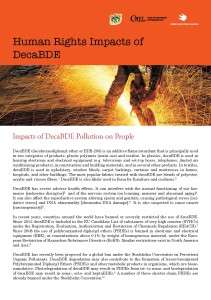 decaBDE: DecaBDE (decabromodiphenyl ether or BDE-209) is an additive flame retardant that is principally used in plastics (like housing electronic and electrical equipment, and construction and building materials) and textiles (like upholstery, window blinds, carpet backings, curtains and mattresses). DecaBDE is also likely used in foam for furniture and cushions. DecaBDE has severe adverse health effects. It can interfere with the normal functioning of our hormones [endocrine disruptor] and of the nervous system (on learning, memory and abnormal aging). It can also affect the reproductive system altering sperm and genitals, causing pathological stress, and DNA abnormality. It is also suspected to cause cancer. Read in English | Español
decaBDE: DecaBDE (decabromodiphenyl ether or BDE-209) is an additive flame retardant that is principally used in plastics (like housing electronic and electrical equipment, and construction and building materials) and textiles (like upholstery, window blinds, carpet backings, curtains and mattresses). DecaBDE is also likely used in foam for furniture and cushions. DecaBDE has severe adverse health effects. It can interfere with the normal functioning of our hormones [endocrine disruptor] and of the nervous system (on learning, memory and abnormal aging). It can also affect the reproductive system altering sperm and genitals, causing pathological stress, and DNA abnormality. It is also suspected to cause cancer. Read in English | Español
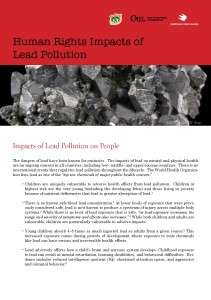 Lead: Lead is the 5th mostly widely used metal. It is commonly found in electronic and electrical equipment such as batteries, cable sheating, glass of CRT monitors, among others. It is a potent neurotoxin, and short term exposure to high concentrations of lead can cause vomiting, diarrhea, convulsions and damage to the kidney and reproductive system. It can also cause anemia, increased blood pressure, and induce miscarriage for pregnant women. Children are considered to be particularly vulnerable to exposure to lead, for it can damage nervous connections and cause brain disorders. There is no known safe blood lead concentration. The World Health Organization lists lead as one of the “top ten chemicals of major public health concern.” Children at highest risk are the very young (including the developing fetus) and those living in poverty because of nutrient deficiencies that lead to greater absorption of lead. Read in English | Español
Lead: Lead is the 5th mostly widely used metal. It is commonly found in electronic and electrical equipment such as batteries, cable sheating, glass of CRT monitors, among others. It is a potent neurotoxin, and short term exposure to high concentrations of lead can cause vomiting, diarrhea, convulsions and damage to the kidney and reproductive system. It can also cause anemia, increased blood pressure, and induce miscarriage for pregnant women. Children are considered to be particularly vulnerable to exposure to lead, for it can damage nervous connections and cause brain disorders. There is no known safe blood lead concentration. The World Health Organization lists lead as one of the “top ten chemicals of major public health concern.” Children at highest risk are the very young (including the developing fetus) and those living in poverty because of nutrient deficiencies that lead to greater absorption of lead. Read in English | Español
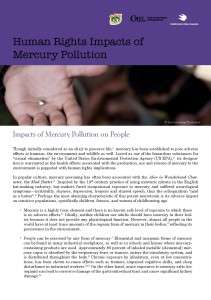 Mercury: Mercury is a highly toxic element used in switches, thermostats, batteries and fluorescent lamps. Like lead, it accumulates in the body, targets the central nervous system, and there is no known safe level of exposure to which there is no adverse effects. Almost all people in the world have at least trace amounts of the organic form of mercury in their bodies, reflecting its persistence in the environment. Perhaps the most alarming characteristic of this potent neurotoxin is its adverse impact on sensitive populations, specifically children, fetuses, and women of childbearing age. Read in English | Español
Mercury: Mercury is a highly toxic element used in switches, thermostats, batteries and fluorescent lamps. Like lead, it accumulates in the body, targets the central nervous system, and there is no known safe level of exposure to which there is no adverse effects. Almost all people in the world have at least trace amounts of the organic form of mercury in their bodies, reflecting its persistence in the environment. Perhaps the most alarming characteristic of this potent neurotoxin is its adverse impact on sensitive populations, specifically children, fetuses, and women of childbearing age. Read in English | Español
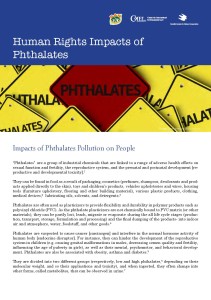 Phthalates: Phthalates are often used as plasticizers to provide flexibility and durability in products. Since they are not chemically-bound to the plastic, they can easily leech into the environment and can be found in food as a result of packaging, cosmetics (perfumes, shampoos, deodorants and products applied directly to the skin), toys and children’s products, vehicles upholsteries and wires, housing tools (furniture upholstery, flooring and other building material), various plastic products, clothing, medical devices, lubricating oils, solvents, and detergents. Phthalates are suspected to cause cancer and interfere in the normal hormone activity of human body. For instance, they can hinder the development of the reproductive system in children, as well as their mental, psychomotor, and behavioral development. Phthalates are also associated with obesity, asthma and diabetes. Read in English | Español
Phthalates: Phthalates are often used as plasticizers to provide flexibility and durability in products. Since they are not chemically-bound to the plastic, they can easily leech into the environment and can be found in food as a result of packaging, cosmetics (perfumes, shampoos, deodorants and products applied directly to the skin), toys and children’s products, vehicles upholsteries and wires, housing tools (furniture upholstery, flooring and other building material), various plastic products, clothing, medical devices, lubricating oils, solvents, and detergents. Phthalates are suspected to cause cancer and interfere in the normal hormone activity of human body. For instance, they can hinder the development of the reproductive system in children, as well as their mental, psychomotor, and behavioral development. Phthalates are also associated with obesity, asthma and diabetes. Read in English | Español
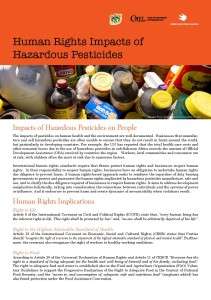 Pesticides: The impacts of pesticides on human health and the environment are well documented. Businesses that manufacture and sell hazardous pesticides are often unable to ensure that they do not result in harm around the world, but particularly in developing countries. International human rights standards require that States protect human rights and businesses respect human rights. In their responsibility to respect human rights, businesses have an obligation to undertake human rights due diligence to prevent harm. Read in English | Español
Pesticides: The impacts of pesticides on human health and the environment are well documented. Businesses that manufacture and sell hazardous pesticides are often unable to ensure that they do not result in harm around the world, but particularly in developing countries. International human rights standards require that States protect human rights and businesses respect human rights. In their responsibility to respect human rights, businesses have an obligation to undertake human rights due diligence to prevent harm. Read in English | Español
